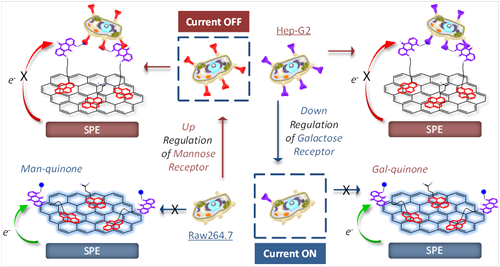
Cells express different levels and types of receptors on the cell membrane under distinct physio- and pathological conditions. The over-expression of certain transmembrane receptors is often a critical signature of diseases. The ingenious probing of the sugar ligand-transmembrane receptor interactions represents a significant subject of research that will contribute to the study of the “glycomics” and facilitate the early-state disease diagnosis.
With continuing interest in preparing sugar-based electrodes and sugar-receptor interaction based living cell capture, researchers from Shanghai Institute of Materia Medica of Chinese Academy of Sciences and East China University of Science and Technology developed an integrated pyrenyl glycoquinone (GQ) construct that can be firmly immobilized onto graphene-spotted screen printed electrodes (SPEs) by strongπ-interactions.
The resulting GQ-decorated graphene SPEs produce an intrinsic voltammetric signal of quinone, which makes possible the label-free detection of selective sugar–protein interactions. The research demonstrates that the SPEs constructed have the ability to track the up- or down-regulated level of pathogenic receptors (the asialoglycoprotein receptors and Mannose receptor) expressed by live cells (hepG2 and M2 macrophage respectively) using simple electrochemical techniques. This study also proves that such detections are based on sugar–receptor interactions by the specific receptor knock-down or induction and free sugar competition.
This work was accomplished by graduate students and colleagues in CHEN Guorong’s, LONG YiTao’s and LI Jia’s groups, providing novel insight into the development of portable and low-cost devices suitable for the tracking of dynamic cellular events with live cells. The findings have been published in Chemical Science.

Figure: Cartoon depicting the dynamic tracking of up-or down- regulated pathogenic receptors expressed by different cells using pyrenyl mannosyl (Man) and Galactosyl (Gal) anthraquinones decorated on grapheme -spottedn screen printed electrodes (SPEs). (Image by SIMM)

86-10-68597521 (day)
86-10-68597289 (night)

86-10-68511095 (day)
86-10-68512458 (night)

cas_en@cas.cn

52 Sanlihe Rd., Xicheng District,
Beijing, China (100864)

